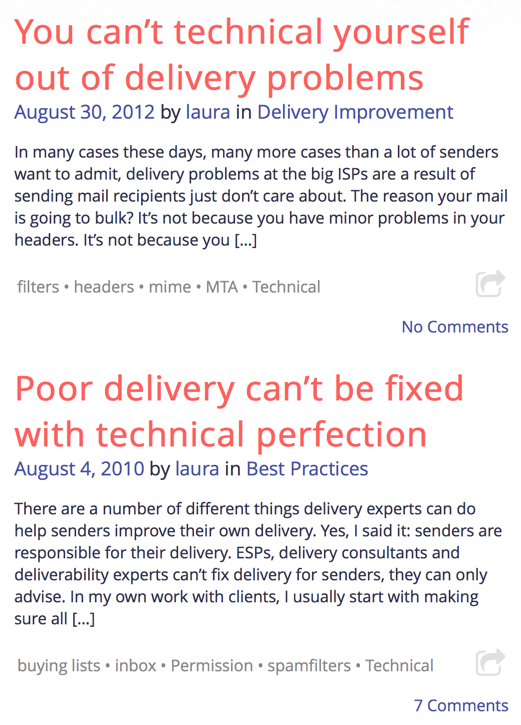Related Posts
Emails that make you smile
- laura
- Aug 20, 2012
This summer’s non-work project for me has been training for a 5K run with Fleet Feet in Menlo Park. As part of the training programs we get weekly emails from the store on Monday. As I was reading through today’s email, I found myself smiling and happy. Lisa, who is one of the store owners and writes the emails, is just so happy and bouncy and thrilled to share her love of running and that comes through in the newsletter.
Our group’s primary coach is the other store owner. During runs we often talk about random stuff, and when I tell people I do email delivery, they always start talking about their experience with email and spam. One night I was running with Jim, and we were talking about Jim’s experiences with sending email. He mentioned their ESP and talked about how convenient it was. But then he mentioned he wasn’t sure that they were sending enough mail (which made me laugh hard enough I almost tripped on a curb).
I realized I am not just a delivery expert when I started thinking about all the ways they could increase the amount of email they send, while still maintaining the quality and the friendly feel of their bulk emails. What could they offer local runners that would increase the value of the store to them? The first very obvious thing was a race calendar. There are dozens of local races every week, telling folks about upcoming races and entry deadlines would be a way to contact folks regularly without it always being a “buy stuff from us!!”
What commercial emails have you gotten recently that have made you smile?
Ask Laura
- laura
- Jan 29, 2016
An Advice Column on Email Delivery
When we work with brands and senders to improve email delivery, there are many questions that come up again and again. For 2016, we thought it might be interesting to answer some of those questions here on the blog so others can benefit from the information.
Confused about delivery in general? Trying to keep up on changing policies and terminology? Need some Email 101 basics? This is the place to ask. We can’t answer specific questions about your server configuration or look at your message structure for the column (please get in touch if you’d like our help with more technical or forensic investigations!), but we’d love to answer your questions about how email works, trends in the industry, or the joys and challenges of cohabiting with felines.
Your pal,
Laura
Dear Laura,
I’m having a hard time explaining to our marketing team why we shouldn’t send email to addresses on our lists with very low read rates, that are dormant but not bouncing, or that spend less than 2 seconds reading our mail. I’m also struggling to convince them that it’s not a good idea to dramatically increase email volume during the holidays (i.e. going from one send/day to 2-3 sends/day).
We already segment based on recency, engagement, and purchase behavior, and we also have some triggered messaging based on user behavior.
Can you help me find a way to help explain why sometimes less is more?
Thanks,
The Floodgates Are Open
Dear Floodgates,
ISPs ask two fundamental questions about email when it comes in:
- Is it safe?
- Is it wanted?
If the answer to both those questions is yes, the mail is delivered to the inbox.
Read MoreDelivery versus marketing
- laura
- Jan 12, 2012
I’ve been thinking lately that sometimes that what works for marketing doesn’t always work for delivery.
For instance in many areas of marketing repetition is key. Repeat a slogan and forge an association between the slogan and the product in the mind of the consumer. More repetition is better. Marketers can even go so far as using the same ad to drive consumer action. Television advertising is a prime example of this. Companies don’t create new content for every advertising slot, they create one or a few ads and then replay them over and over. The advertiser doesn’t even really care if the consumer consciously ignores the ads. The unconscious connection is still being made.
In the world of email delivery, though, having many or most recipients ignore advertising is the kiss of death. Too many unengaged users and filters decide that mail shouldn’t go into the inbox. These don’t even have to be ISP level filters, but Bayesian filters built into desktop mail clients.
Sending repetitive ads over email may be an effective marketing strategy, but may not be an effective delivery strategy.
Am I off base here and missing something? Tell me I’m wrong in the comments.
